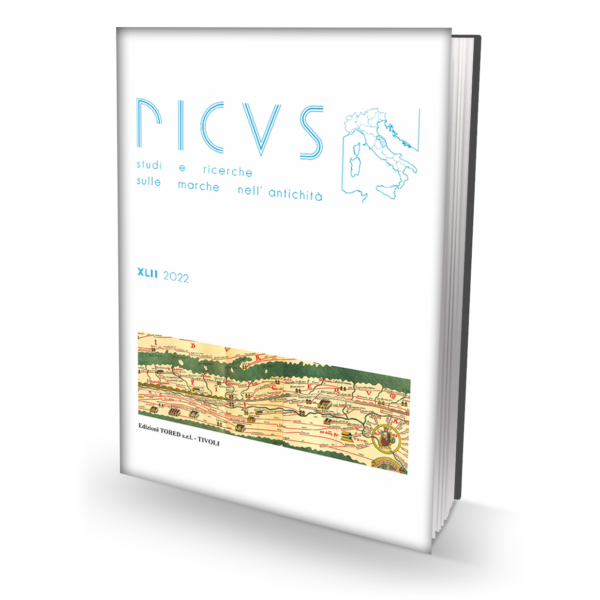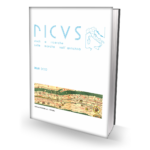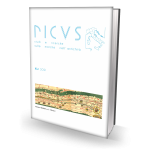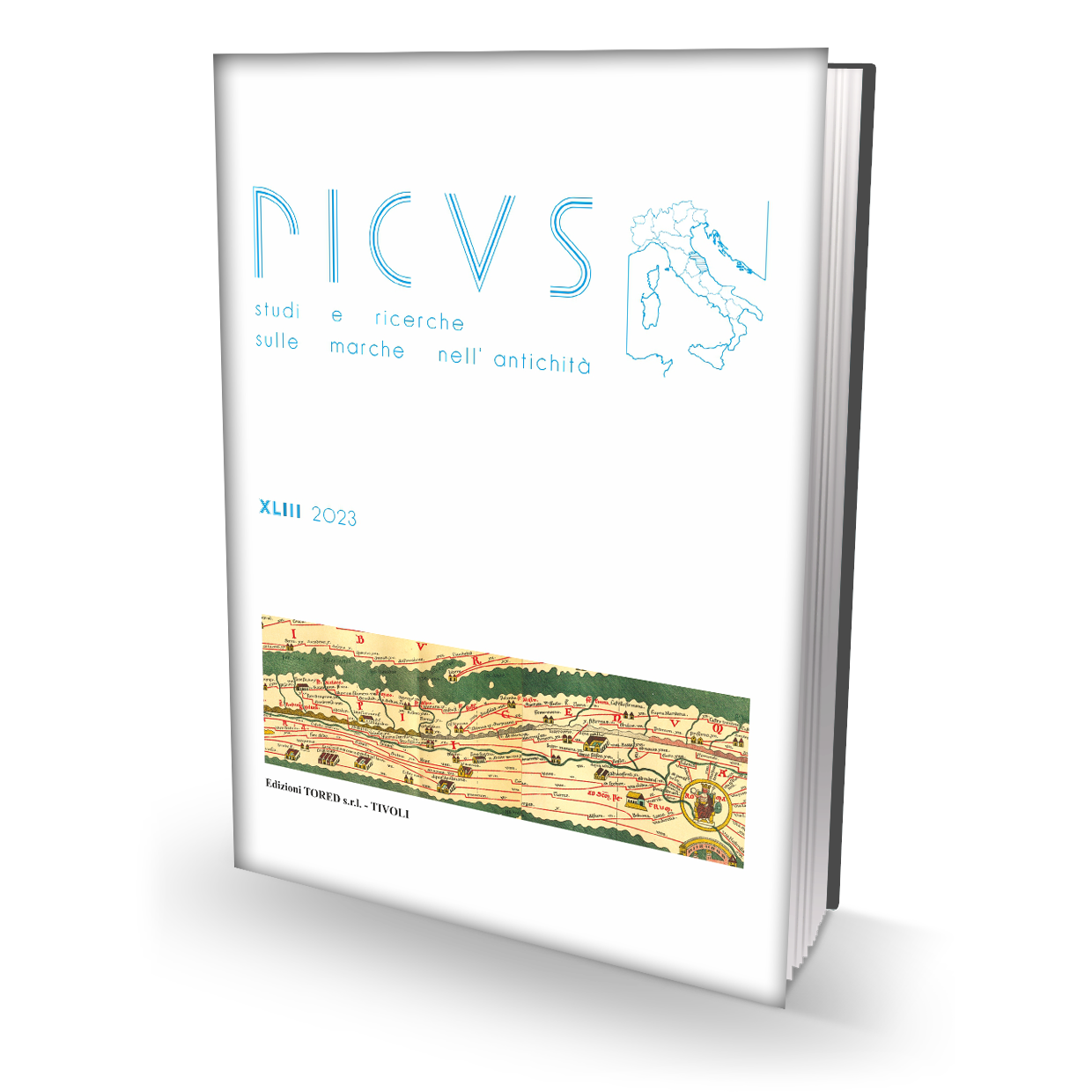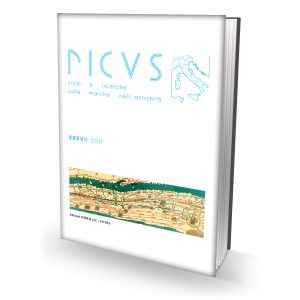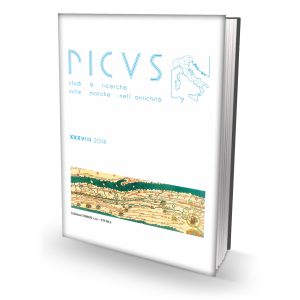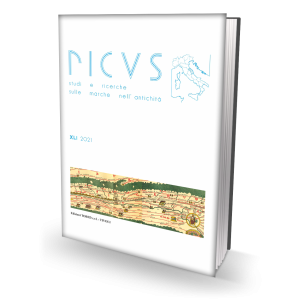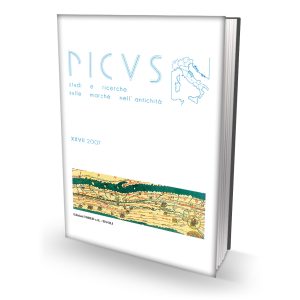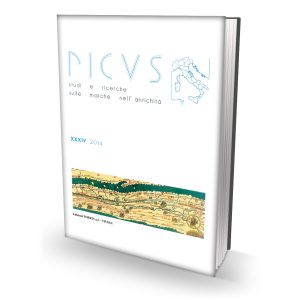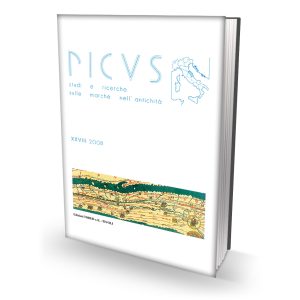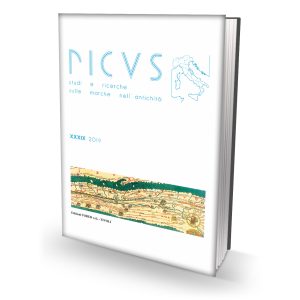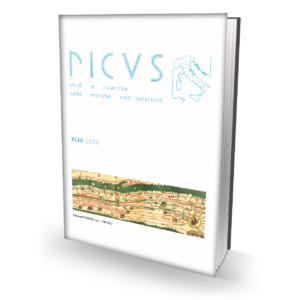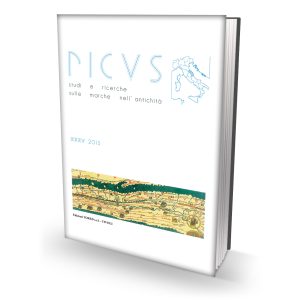PICUS XLII – 2022. STUDI E RICERCHE SULLE MARCHE NELL’ANTICHITÀ
50,00 €
Anno Edizione: 2022
Formato 17×24 – Pagine 320
Confezione a filo refe con copertina 4 colori
ISSN 0394-3968 – ISBN 9788899846992
Prezzo: € 50,00
- Descrizione
- ABSTRACTS
Descrizione
Indice del Volume
Saggi e articoli – L’area plestino-camerte in età medio repubblicana. Ceramica e storia tra Tirreno e Adriatico:
– L. Brecciaroli Taborelli, Dal Tirreno all’Adriatico. Ceramiche fini di IV – II secolo a.C. nell’area plestino camerte
– S.M. Marengo, Ceramica a vernice nera graffita da Camerino a Pievefavera
– G. Paci, Dall’umbro al latino. I frammenti ceramici a v.n. iscritti dal santuario di Cupra a Colfiorito
S. Antolini – E. Hobdari – Y.A. Marano, Un diaconus Sancti Stephani de provincia Anconitana a Scampis (Epirus Nova)
R. Perna, Il foro di Pollentia-Urbs Salvia tra l’età repubblicana e imperiale
Note e relazioni: F. Boschi, Per uno scenario rinnovato della presenza picena nelle Marche settentrionali: le ricerche nella necropoli di contrada Nevola a Corinaldo – M.R. Ciuccarelli – M. Silani, Indagini archeologiche a Villa Tarsi (Senigallia, AN): nuovi dati sull’impianto di Sena Gallica dalla fondazione della colonia all’età tardo antica e alto medievale – G. Paci, Ancora sulla colonia Aesis
Schede e notizie: V. Lani, Via Flaminia: vecchi e nuovi rinvenimenti a sud di Pisaurum
Bibliografia
Recensioni: T. Capriotti, L’Adriatico medio-occidentale. Coste, approdi e luoghi di culto nell’Antichità, Roma 2020 (C. Delplace) – P.L. Dall’aglio – C. Franceschelli (a cura di), Ostra: archeologia di una città romana delle Marche (scavi 2006-2019), Bologna 2020 (R. Perna)
Schede per località: Ostra Vetere (AN) (Redazione) – Pesaro (PU) (M.R. Ciuccarelli – C. Delpino)
Segnalazioni: a cura di F. Cancrini – G. Paci – M. Pasqualini
Saggi e articoli
L’area plestino-camerte in età medio repubblicana. Ceramica e storia tra Tirreno e Adriatico:
L. Brecciaroli Taborelli, Dal Tirreno all’Adriatico. Ceramiche fini di IV – II secolo a.C. nell’area plestino camerte, p. 9-88
Area of passage and of meeting as well as material and cultural exchanges, the territory occupied by the Umbrian communities of the Plestini and the Camertes lies in the Umbria-Marche Apennines ending southwards with the Sibillini Mountains. Crossed by routes of the transhumance from the south-west to the north-east, linking the winter pastures of the viterbese Maremma and the summer pastures in the central Apennines. It is legitimate to suppose that the desire to control this trans-Apennine route leading to the stipulation of the foedus between Rome and the Camertes (310 B.C.). As subsequent events confirm, this diplomatic initiative marked the beginning of Roman expansion towards the central-northern Adriatic coast. At present, the evidence providing a picture of the continuity and change within the Umbrian Apennine communities in contact with the Latin world consists almost entirely of ceramic artefacts, in particular figured and black glaze wares. They permit to assess the impact of increasing contact with the Etrusco-Latin world on the socio-economic structure and traditions of this Umbrian territory from the very beginning of involvement into Roman political and cultural sphere. Adriatic Umbria, Apennines, ceramics, population, Romanization, transhumance.
S.M. Marengo, Ceramica a vernice nera graffita da Camerino a Pievefavera, p. 89-107
The paper examines 14 black painted ceramic finds, all inscribed, from the territory of the Camertes, border between Umbri and Piceni, dated late IV-III century B.C.; graffiti testify personal names, alphabetic signs and non-alphabetic signs; they documents writing, onomastic, cult practices in the age of romanization. Litberacy, romanization, graffiti, black painted ceramic, umbrian territory
G. Paci, Dall’umbro al latino. I frammenti ceramici a v.n. iscritti dal santuario di Cupra a Colfiorito, p. 109-118
Un important groupe de tessons de céramique à vernis noir (3e – 2e s. av. J.-C.), au nombre de 12, dont beaucoup portent, sous laforme de graffiti, les noms de dévots, a été retrouvé dans le sanctuaire de la déesse Cupra à Colfiorito. Heureusement intégrés dans le cadre de la reconstruction historique du territoire effectuée récemment, ces fragments permettent de comprendre le processus de transformation qui a touché la population du haut plateau durant cette même période. Les graffiti sont rédigés dans l’alphabet latin qui a désormais remplacé l’alphabet ombrien dans lequel étaient encore rédigées les quatre lamelles en bronze assignées au 4e s. et qui proviennent du même sanctuaire. D’autre part, la finale en -ie(s) de pratiquement tous les gentilices, que l’on peut relier au génitif singulier ombrien des noms en -io-, montre comment ces derniers sont encore rédigés dans la langue indigène. Les tessons avec graffiti sont donc un témoignage précieux d’une étape intermédiaire du processus de transformation qui prendra fin avec le passage au latin à l’époque de la création du municipe. En mème temps, ce matériel documentaire nous montre comment la céramique à vernis noir, considérée à juste titre comme un apport de la colonisation et associée normalement à la présence de colons romains, peut déborder son espace de diffusion jusqu’à atteindre des sites et des espaces de territoires qui ne sont pas touchés diredement par ce phénomène. Céramique à vernis noir, sanctuaires et romanisation, substitution de l’alphabet latin à l’alphabet ombro-sabellien, graffiti en langue ombrienne rédigés en alphabet latin.
S. Antolini – E. Hobdari – Y.A. Marano, Un diaconus Sancti Stephani de provincia Anconitana a Scampis (Epirus Nova), p. 119-145
The paper examines a new Latin inscription found at the site of the early Christian basilica extra muros of Scampis (today Elbasan, Albania). The text commemorates a diaconus Iustus de provincia Anconitana, germanus (brother) of bishop Marcellinus, who possibly took part into the embassies sent to the East by the popes in 519-520 or 535 AD.
Scampis, early Christian inscription, diaconus, Church of Ancona, bishop Marcellinus.
R. Perna, Il foro di Pollentia-Urbs Salvia tra l’età repubblicana e imperiale, p. 147-180
This article focuses on the monumental development of Pollentia-Urbs Salvia Forum from the very early stages of occupation in the 3rd-2nd century BC up to the final definition of the public space of the site as a consequence of the urban and social development of the town.
Picenum, Marche, urban planning, cults, Roman time
Note e relazioni:
F. Boschi, Per uno scenario rinnovato della presenza picena nelle Marche settentrionali: le ricerche nella necropoli di contrada Nevola a Corinaldo, p. 183-206
The contribution presents an updated overview of the investigation that led to the discovery of an Orientalising Picenian necropolis in Corinaldo, near Contrada Nevola. The interdisciplinary methodology and commitment of the various institutions involved in the ArcheoNevola project are at the basis of the most recent acquisitions, which enrich the knowledge of the important site in addition to address a territorial planning intervention using the methods of preventive archaeology. After the first investigations, the latest excavation campaigns and new analyses describe the funerary area with further details, especially regarding the Picenian funerary nucleus, but also the burial ground developed in proximity during the Roman imperial age, the exploration of which contributes to the understanding of the development of the funerary landscape in the longue durée.
Corinaldo (AN), orientalising Picenian Necropolis, preventive archaeology, Roman burial ground.
M.R. Ciuccarelli – M. Silani, Indagini archeologiche a Villa Tarsi (Senigallia, AN): nuovi dati sull’impianto di Sena Gallica dalla fondazione della colonia all’età tardo antica e alto medievale, p. 207-248
This paper illustrates the results of the investigations conducted by the Soprintendenza Archeologia, Belle Arti e Paesaggio delle Marche in the ex-Villa (and Mulino) Tarsi in the historic centre of Senigallia (AN), between October 2019 and June 2020. The excavation of a substantial and well-preserved archaeological deposit has made it possible to reconstruct seven main periods in the city history, from the foundation of the Roman colony to the present day. Among the many lines of research opened up by the new excavations, this contribution focuses on the detailed description of the archaeological evidence and proposes a new reconstruction of the southern sector of the urban layout of the colony of Sena Gallica between the Republican and Imperial periods.
Sena Gallica, urban settlement, medieval burial ground, Pollia, votive deposits.
G. Paci, Ancora sulla colonia Aesis, p. 249-265
On the colony at Aesis, if on the one hand the literary source (Vell. I, 14, 8), cointaining the corrupted form of the toponym of the town, should be dimissed, on the other hand other sources point towards a colony dating to the Augustan or to triumviral period; perhaps the colony might date to the 2nd century BC at the Graccan time. This latter hypothesis is supported by the lack of mention of Aesis in the list of colonies supplied by Pliny the Elder.
Aesis, Velleius Patercolus, Roman colonization in the 1st-2nd cent. BC; Graccan colonies.
Schede e notizie:
V. Lani, Via Flaminia: vecchi e nuovi rinvenimenti a sud di Pisaurum, p. 267
The recent discovery of large blocks in cement conglomerate, collapsed from the mountain near SS. 16, a few km from Pesaro, offers the opportunity to reconsider the path of ancient Flaminia, thanks old and new archaeological data.
Flaminia, substructures, Pisaurum, Fanum Fortunae.
Bibliografia
Recensioni: T. Capriotti, L’Adriatico medio-occidentale. Coste, approdi e luoghi di culto nell’Antichità, Roma 2020 (C. Delplace), p. 283-290
P.L. Dall’aglio – C. Franceschelli (a cura di), Ostra: archeologia di una città romana delle Marche (scavi 2006-2019), Bologna 2020 (R. Perna), p. 291-294
Schede per località:
Ostra Vetere (AN) (Redazione), p. 295
Pesaro (PU) (M.R. Ciuccarelli – C. Delpino), p. 295-307
Segnalazioni: a cura di F. Cancrini – G. Paci – M. Pasqualini, p. 309-317

